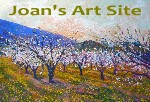Transatlantic Crossing 2009
Part One - Lagos to the Canaries and preparations for the crossing
Alan's Log:
Joan's Log:
November 17th 2009
Passage from Lagos, Portugal via Madeira to the Canary Islands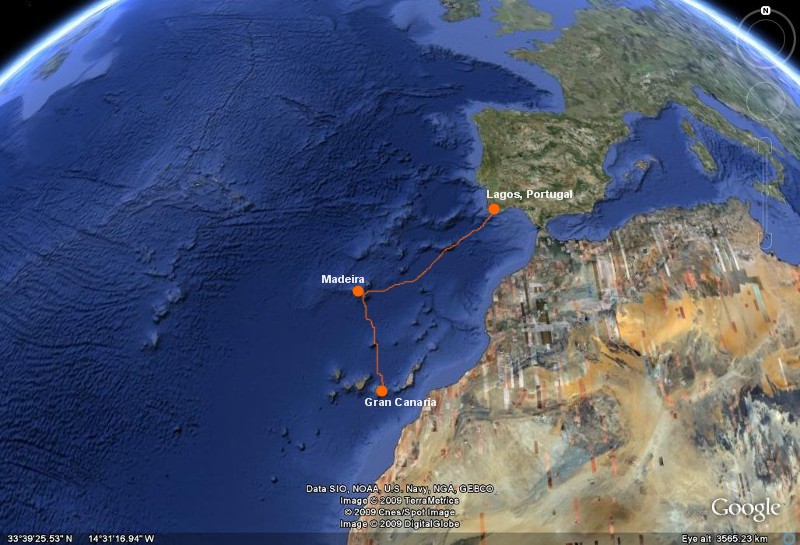
Not to be used for navigation
Sam flew in from the UK to join us for the 700NM sail from Lagos to the Canaries and we set off in light winds heading towards our first stop in Funchal, Madeira. At around midnight on our first night at sea the wind started to build and we were finally able to hoist sail and shut off the engine. We sailed for the next two days, enjoying a protracted visit from a large pod of dolphins en route before finally turning the motor back on as we neared Madeira.


We pulled into Funchal Harbour to tie-up only to find it completely full of 21' one-design racing sailboats.
It took a couple of attempts to set the anchor in the area just outside the harbour during which we met Inders, a young Dane on DANIA who kindly swam over and introduced himself, then offered to dive and check the anchor set!


We dinghied in to the harbour to discover that Funchal harbour had been taken over for the week by the participants of the solo mini-transatlantic race.

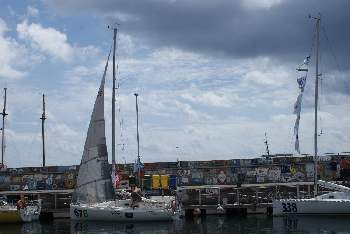
The sailors set off from France, sailed non-stop to Madeira, then will leave Madeira and sail non-stop to the finish line in Bahia, Brazil. It is an awfully long way to sail by yourself in a 21' boat. With a storm brewing in the mid-atlantic and Sam needing to get to the Canaries in time for his flight we did not linger in Funchal. After a day or two looking around town we set sail in 15-20 knots of wind for Las Palmas, Gran Canaria. The wind took us halfway and we motored the rest.
Las Palmas, Gran Canaria
October 3rd 2009.This will be our home for nearly two months. The pilot books for these waters recommends leaving Europe for the Canaries no later than September, and then leaving the Canaries no earlier than November, so we have plenty of time here in the Canary Islands to take care of maintenance, check out all our safety gear and to get to know some of the other sailors planning a similar voyage.
There are a few places around the world where sailors gather and I am not talking about bars! These are the ports where most long ocean voyages traditionally start or end and there is usually a good reason for the location. Christopher Columbus took off from the Canary Islands on his voyages to the New World for the same reasons that we are taking the same route 517 years later. The wind blowing through the Canaries should take us first south down the African coast as far as the Cape Verde islands and then West on a straight shot for the Caribbean, while hopefully avoiding the doldrums that lurk in the mid-atlantic.
Here is a sample Weather map for this week. The arrows indicate wind direction and speed. The barbs on the tails of the arrows indicate wind speed, a half bar is 5 Knots a long bar is 10 knots. So three long bars would be 30 Knots.

So we are following in Columbus's wake and there are literally hundreds of other yachts here in Las Palmas with the same general plan.
Every day a few more yachts arrive. The flags are mainly European: British, French, German, Dutch, Norwegian, Swedish, Swiss, Austrian. Many are joining us in an organized Transatlantic rally the "Atlantic Rally for Cruisers", known universally as the ARC. Others are planning to follow the same general route of the ARC or are simply planning their independent voyages at the optimum time according to history and meteorology.
Along with the arriving boats are crews flying in to join the boats, and travellers who are hoping to become crew. The latter have flown to Las Palmas with one-way tickets to spend the days tramping the docks hoping to hitch a ride to the Caribbean and gain experience of ocean sailing along the way. They are uniformly young - as young as 19, keen, confident, with plans of seeking work in the Caribbean in the charter business, or another ride onwards. While in Las Palmas they stay at the hostel overnight or find cheap berths around the marina and during the day they walk the docks, engage the skippers in conversation and hang out in bars, hoping to find a captain on a sound boat that will take them on. Some are couples, but most are travelling alone.
I have been very tempted adopt one or two as extra crew. As our departure date gets closer you can hear the desperation in their voices, last night as we were having drinks in the cockpit with our old friend John, from J'Sea, a young man stopped by to ask if we needed crew. When he was told no we have all we need, he asked "are you sure?" I would have said "yes, but you'll have to sleep on the floor" He probably would have been OK with that.
The other day two yachts left. One an 80' classic wooden yacht and the other a 125' superyacht. As each left it was serenaded with foghorns blowing throughout the harbour. These yachts will arrive in the Caribbean before we leave the Canaries!
We have maintained the engine, ordered parts for our Generator, sanded and varnished the brightwork and added temporary storage bins behind the saloon table for supplies for our long voyage. Between chores there has been plenty of time to explore the island of Gran Canaria. Las Palmas is a large city with a huge commercial harbour and high-rise apartment buildings as far as the eye can see. The climate is hot and dry but the city parks are lovely and luxuriant. They are all watered, and it was only when we rented a car that we realized the majority of the north part of the island is an arid mountainous desert.

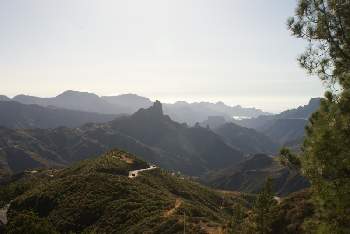
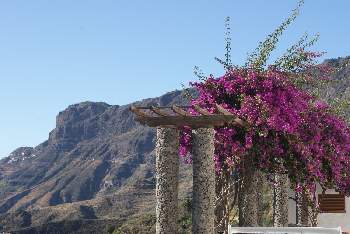





We drove further afield and escaped the burnt brown soil and bare rock of the immediate area surrounding Las Palmas for the luxuriant interior of the island. Unfortunately much of the cultivation here is under the same enormous plastic sheets as in Southern Spain. Good for the fruit but deadly for the environment as well as the scenic photographer/tourist. The scenery here is blighted by these monstrosities.
We are getting to know our neighbours. To the left is a Swedish family and to the right an Austrian Family. The Austrian Family is on a 50' catamaran, ULYSSES. The parents are Italian/Austrian and 8 of their 9 children are living on board with them.

The father moans that despite every attempt to lighten his boat for passage he has to paint the waterline higher each year. They carry over a ton of school books for homeschooling. The children range in age from 4-19 and carry passports from the countries they were born in, all over the world. They are true world citizens. The entire family is beautiful, mother and father included. The little boys all have long, tangled blonde hair, and have names like Estrella (star) Papillon (Butterfly) Soleil (sun). I call them The Wild Things, Lauren calls them monkeys, which is appropriate for the way they swing from the boom and pop in and out of the hatches. They left about a week ago for Brazil. We miss the pitter patter of their little feet running up and down the pontoon.
November 16th 2009
The pace is quickening here in Las Palmas. Nearly all the ARC boats have arrived and the Marina is a sea of ARC rally flags, the national flags of over 50 nations and colorful codeflags decorate most of the yachts.

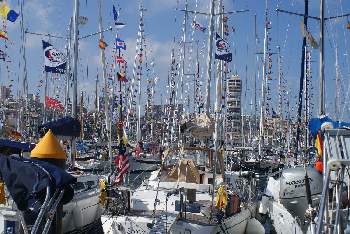

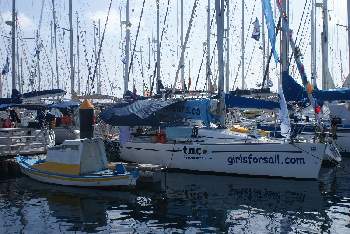
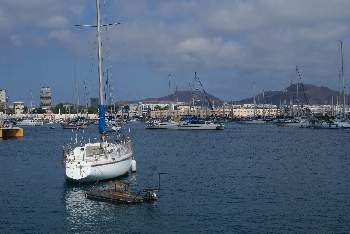
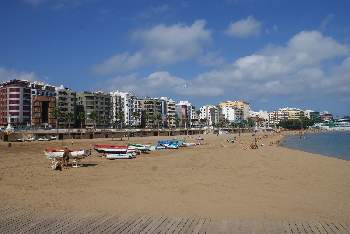
It is a tradition to "dress ship" before a rally like this and we all put up our signal code flags and hoist them to the top of the mast. Tourists are wandering up and down taking pictures of all the activity and asking us questions like "where do you stop at night during the crossing?"
The hopeful crew walking the docks have an increasingly worried look as it becomes apparent that some of them may not get berths before the departure.
Yesterday our friend John from JSEA arrived. He sailed across the Atlantic in our group in 2007 and we enjoyed his comany in the Azores and Lagos following that event. This year he left his departure from Marmaris until the last minute and pretty much had to motor the length of the Mediterranean covering 3,000 NM in two weeks with the wind on the nose. Not a fun voyage but we are glad he is here, as is KITTIWAKE, another yacht from our 2007 crossing. We are all about the same size so there is a possibility that we will be within radio range of each other for at least part of the voyage.
Tonight is a dinner/dance for boats of our size category. It will give us a chance to meet and chat with the crews on boats that share our approximate speed and consequently those that we expect we will be closest to during the voyage. We will have a daily radio position report which will help us keep track of everyone and if we meet some sympatico souls at the dinner we may have someone to talk to during the long boring days.....over the SSB/HF longdistance radio.
Sam arrived a few days ago with his wife Camilla, and our long awaited replacement exhaust elbow for the genset. Our only major remaining job is to replace this part and service the Genset (oil/filters/impeller) as we will be relying on it to recharge our batteries every day as we sail across. It takes about 3-4 hours of charging every day to compensate for the electrical loads of the Watermaker, Fridge, Freezer, Autopilot and Navigation Lights.
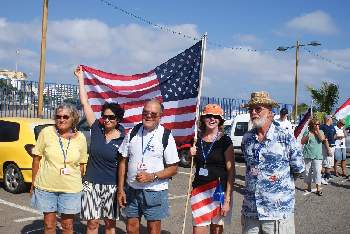
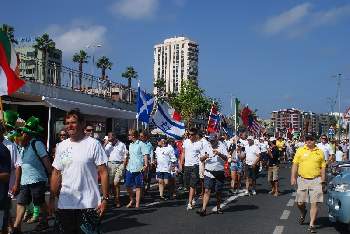
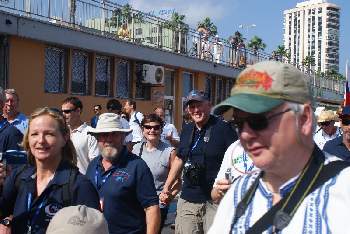
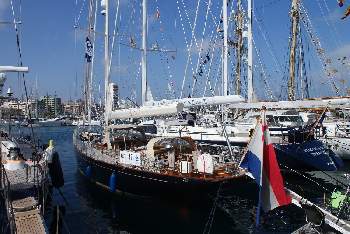
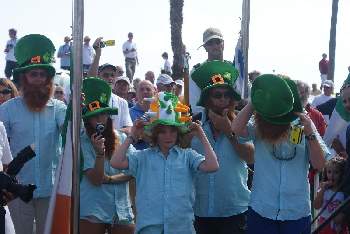

We hope to be able to update the website during our voyage using our sat-phone. The cost is high and the data transmission speed slow so we will upload text only, but we will try to update our log every few days. We will add pictures to it once we arrive in St Lucia in the Caribbean.
Next...TRANSATLANTIC LOG 2009

